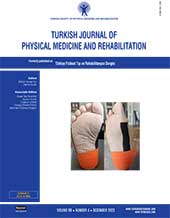Effectiveness of kinesiotape and sham kinesiotape application in children with cerebral palsy with dysphagia: A randomized controlled study
2 Department of Physical Medicine and Rehabilitation, University of Health Sciences, Dışkapı Yıldırım Beyazıt Training and Research Hospital, Ankara, Türkiye DOI : 10.5606/tftrd.2023.11066 Objectives: This study aimed to investigate the short- and long-term effects of kinesiotaping (KT) on dysphagia in children with cerebral palsy (CP).
Patients and methods: One hundred one CP patients (59 males, 42 females; mean age: 49.3±18.8 years; range, 2 to 6 years) with dysphagia referred between October 2017 and January 2020 were enrolled in the randomized controlled study. Children who met the study criteria were randomly assigned to the kinesiotape group (n=54) or the sham group (n=47). Specific swallowing evaluations were performed on all patients before the therapy. The KT or sham application protocole combined with conventional rehabilitaion therapy was conducted for six weeks. Evaluation parameters were repeated at 6 and 18 weeks. The evaluated parameters were compared within and between groups.
Results: Drooling, weak tongue movement, chewing difficulty, coughing/choking and retching/vomiting during/after feeding, functional oral intake score, and meal time were found to be significantly improved at six weeks in the kinesiotape group compared to the sham group, and the clinical improvements were present at 18 weeks (p<0.05). There was no statistically significant difference in any parameter in the sham group at 6 and 18 weeks compared to the pretreatment (p>0.05).
Conclusion: The addition of KT to a home exercise program is an effective method for dysphagia in CP.
Keywords : Cerebral palsy, dysphagia, kinesiotape, rehabilitation, swallowing

















